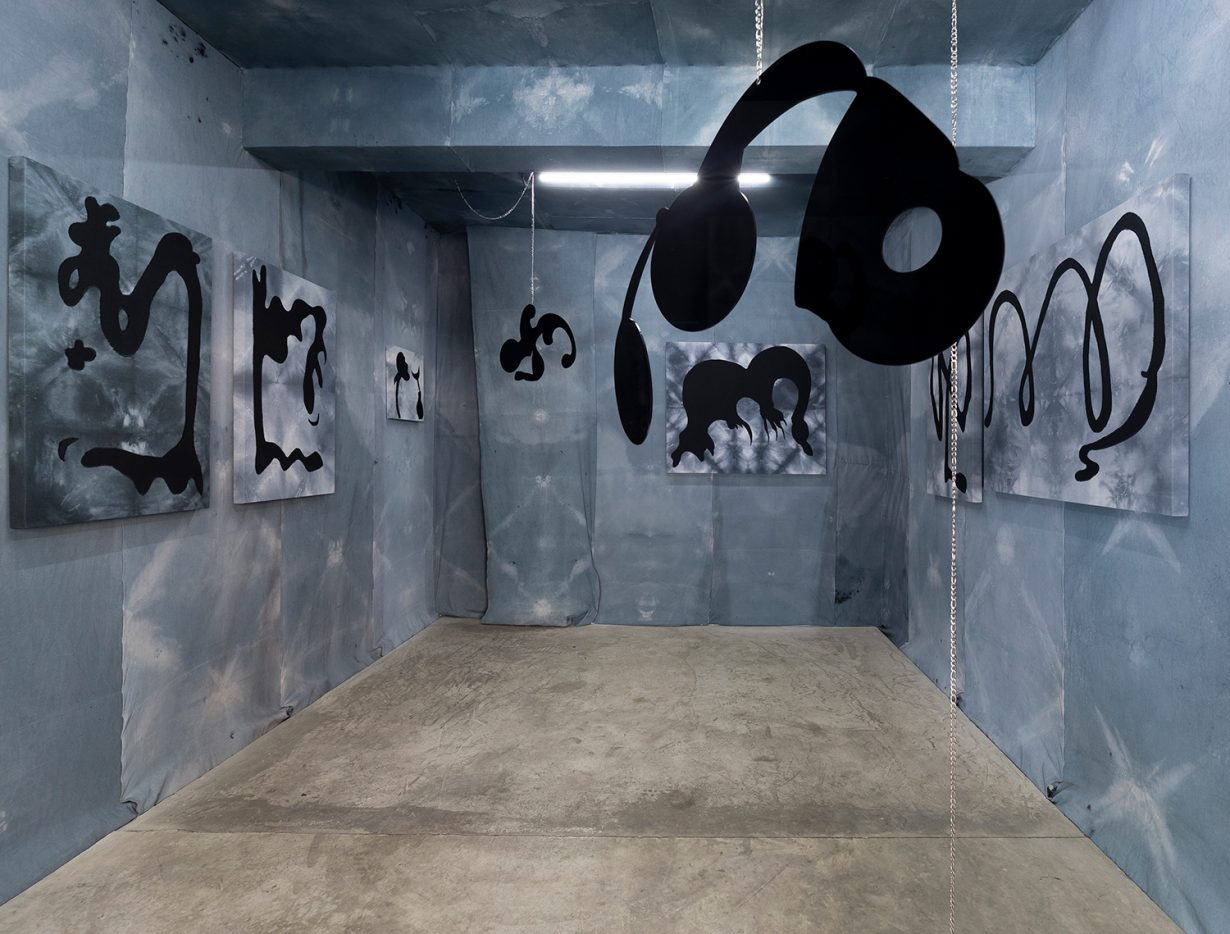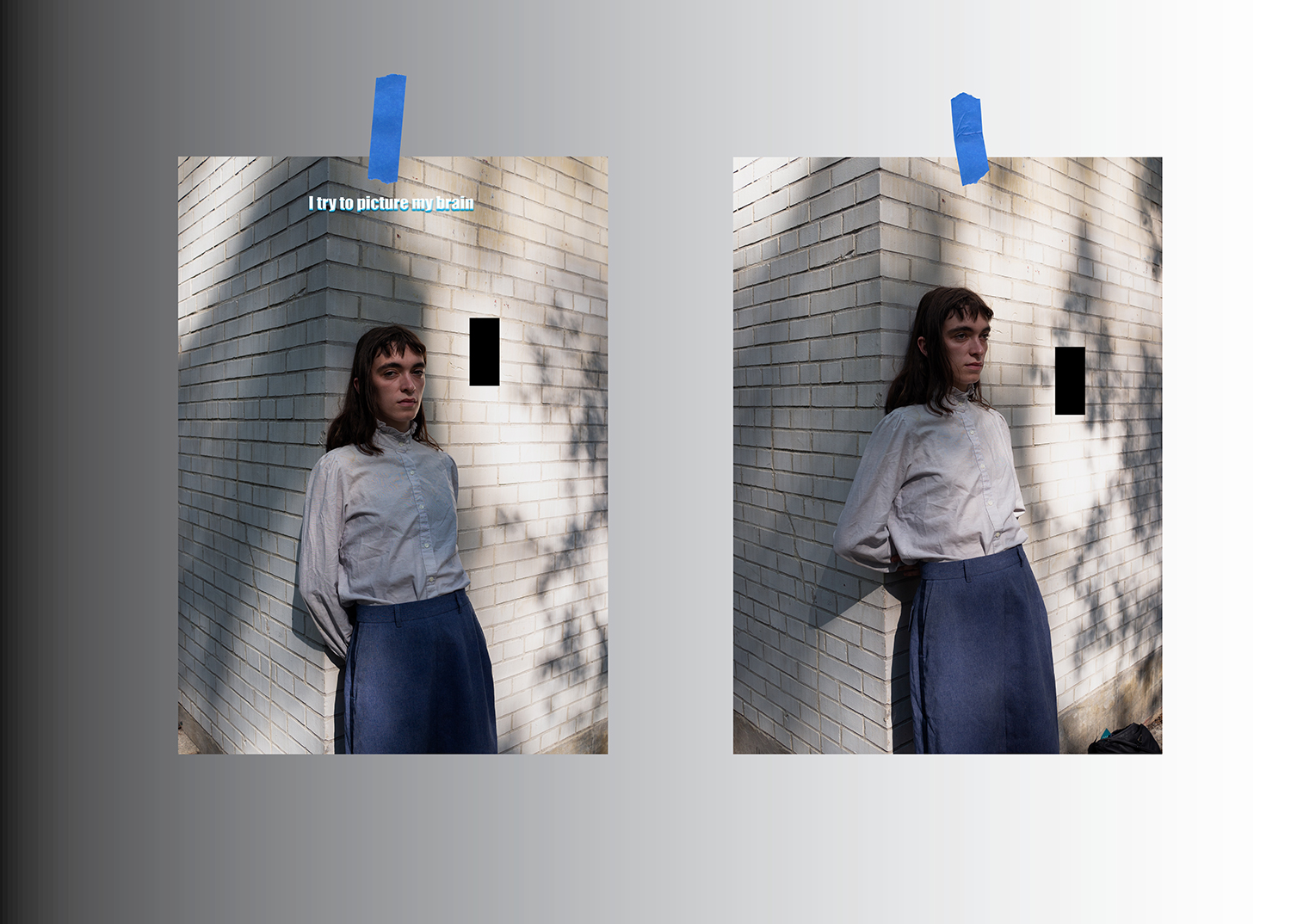A walk through Mexico City’s galleries prompts a rumination on an unshapely motif
‘I try to picture my brain… While something destroys the world and fills it with bubbles.’ These are the first words you encounter at Bernadette Corporation’s exhibition at House of Gaga. The show is composed of a dozen posters: many of them featuring photographs of Meetka Otto, a young New York model wearing a modest Victorian-style collared shirt and a blue denim midiskirt; some displaying kitschy works by other artists (named in the text that accompanies the show as Joseph Tidwell, Cecilia Fraher and Jennifer Lacy); all sprinkled with cryptic writing. Sentences like, ‘Instead of form, we say, “for me”’, ‘A blob is something that comes and is for you’, ‘The blob… intentionally built by someone or something’. There’s a list of words (listed again in the accompanying text) purposefully removed from these phrases that includes ‘quarantine, avatar, COVID, 5G, prisoner’. In a row of six nearly identical images printed as three posters (Bubbles, 2021), Otto looks softly at the viewer while standing with her hands behind her back at the corner of a white-brick building. In a new twist to Bernadette Corporation’s interest in identity dissolution – such as their explorations of anonymous collectivity in Black Bloc riots in the film Get Rid of Yourself (2002), or the dilution of authorship in the multiple writers of their novel Reena Spaulings (2004) – the idea on which this show is centred is blobs; more precisely, ‘a writing mechanism which led to the discovery of blobs’. We are not told what the mechanism is, or how it works, but that blobs are, among other things, ‘not text’, that Otto is the embodiment of the blob and that the posters are portals to go inside it. Some of the posters are plastered on doors hung flat and vertically against the wall, one is on a door hung horizontally and slightly askew, and others are on doors that rest on the floor and lean against the wall, which makes them literal portals.

It brings to mind the use of poststructuralist critique by Rosalind Krauss and her contemporaries to pick apart concepts that had long held some of art’s most sturdy structures in place, medium-specificity and authorship among them. The October crop of critics of the 1980s would seem like the primordial soup from which the primarily New York-based Bernadette Corporation emerges fully formed during the early 90s: a somewhat anonymous collective completely obsessed with French theory and rebuffing whatever was left of discrete cultural mediums by working in fashion, film, literature and visual arts. Back then, Jacques Derrida’s questioning of language and its universality paved the way for so much postmodernist critique, but in today’s atomised world it feels hard to locate a totalising discourse against which to revolt in the first place. Now that the logic of capital and monetisation has infiltrated every possible form of communication, is it possible to enunciate our collective desire in non-presanctioned political language?
The COVID-19 crisis has shown us not only that state structures and institutions are simply dysfunctional fictions in this part of the world – one in which poststructuralism was widely embraced by art discourses and the academy – but it has also made it easier for us to be pitted against each other by the mediums we use to communicate and the very concepts through which we are supposed to be emancipated. In our ‘new normal’, we are all too often confined to tiny bubbles on a Zoom call and by the networks of our social-media feeds. And we seem to be adapting to that environment far too quickly and unthinkingly. It’s as if the conversations we are used to having for all kinds of reasons – work, school, friendship – are now so intensely mediated by digital media that we are starting to take after its logic. Social media does not reward nuanced exchange nor detailed exegesis; rather it boosts distanced but easily communicable clichés and buzzy keywords thrown around under the assumption that everyone conceives of them in the same way and that they are not worth unpacking. Moreover, we’re all starting to sound and read like this beyond the bubbles of our Twitter feeds or our too-long Instagram captions. Perhaps October and the intellectual niche it engaged with was already its own kind of bubble, as most art communities tend to be, with their own jargon and feuds, but it was one with a passion for discourse, even if that meant relentlessly picking it apart.
To go back to blobs, these manifest today in Mexico City as a tendency to erode the discourse-oriented political art practices that have dominated ‘young Mexican Art’ for decades. Generation after generation tries to pull away from them only to end up discussing priismo and Mexican modernism over and over. Yet in our current chaos, which I argue is tinted by a general distrust of all kinds of discourse, including its political and art-historical incarnations, there are artists pushing back with a wariness of language as material.

Milagros Rojas, an Argentinian-born, Mexico City-based artist, presents Que el día se convierta en noche (That the day may turn to night) at Salón Silicón. For this show she has covered the walls of the small gallery in tie-dyed dark aquamarine fabric, a deep, nonneutral background atop of which hang canvases stretched over with the same material and populated by stitched-in blobs. Rojas’s blobs are a lot more defined than Bernadette Corporation’s, and a lot more recognisable as such: rounded and soft, shadowlike, although some of them could also pass for squiggles. They are pitch-black shapes, all irregular edges, like a drop of crude oil that fell from too high up or the shadow of a prehistoric amoeba cast on moving water. For her, the black blobs are attempts at a new material medium of communication, a mutant alphabet. Rojas is thinking of the dysfunctionality of language and what she considers to be its excessive specificity. Even within the various but still finite meanings Derrida would argue every word or sentence represents, she finds constriction and obstruction, a predetermined mode of existence, an inescapable logic.
On that note, another excerpt from Bernadette Corporation’s show states: ‘As the blob grows, we realize that it’s our brain… and some years later we realize other people are there too…’ The blob appears then as our own personal bubble, our personalised brain-echo chamber, atomised as it now is by the customised content furiously funnelled into our minds at all times. For Rojas those self-exile bubbles are made even more inescapable by our irredeemably rigid language, for which she suggests a malleable, inchoate alternative, one that could follow Bernadette Corporation’s repeated slogan: ‘Instead of form, we say, “for me”’. What would a blob that is ‘for us’ behave like, then? A good starting point appears in the second part of that assertion: ‘I want you to give me this power to you’.
Bernadette Corporation: I Accept, House of Gaga, Mexico City, 25 February – 3 April 2021; Milagros Rojas: Que el día se convierta en noche, Salón Silicón, Mexico City, 11 March – 3 April 2021
